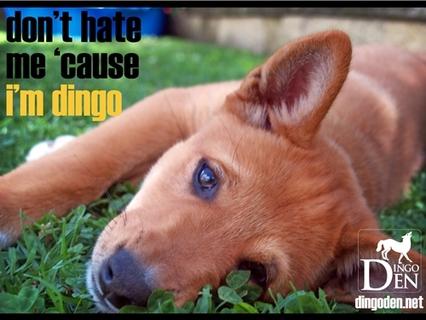UNDER THREATWARNING: this page contains some graphic content and may be upsetting to some people.
Losing a species Even though the dingo is listed as a vulnerable species by the International Union for the Conservation of Nature and Natural Resources (IUCN), the dingo is still the only Australian mammal not protected under the National Parks and Wildlife Act.
Instead, the dingo is regarded as a wild dog under the Rural Lands Protection Act. Wild dogs are declared 'noxious animals' under that legislation, so they cannot be protected under the National Parks and Wildlife Act. Under the Rural Lands Protection Act, the dingo is subject to government-funded trapping, baiting and hunting bounties. Additional threats exist from private culling, wild dog fencing, and contact with the domestic dog, Canis lupus familiaris. Due to being branded a 'noxious animal', the dingo is exposed to a myriad of unnatural threats that it can not compete with, resulting in the pending loss of the species. Many conservationists believe that the conservation status of the Australian Dingo varies between threatened and critically endangered, fearing its extinction by 2020. To prevent the extinction of the dingo the species must be removed from the Rural Lands Protection Act as a wild dog and noxious animal, and be included as a native species under the National Parks and Wildlife Act. Furthermore, urgent and thorough investigations of the dingo's conservation status must be conducted, and if established as a threatened species, the dingo must be listed under the Threatened Species Conservation Act 1995 of which the Office of Environment and Heritage is responsible to protect. Adult Culls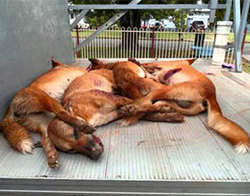
Every year, thousands of dingoes are shot, trapped, poisoned, fumigated and hunted in an effort by anti-dingo enthusiasts to exterminate the species permanently from Australia. Dingo culling originated in the period in which Australia was being colonised by Europeans. Land owners of the time were encouraged by the Crown to destroy dingoes that were on their properties, and were fined by the Crown if they did not comply. The war against dingoes has been a 200 year saga that has seen many dingo subspecies become extinct. The timid Aussie dingo is losing the battle with its entire species facing extinction by the year 2020.
Puppy culls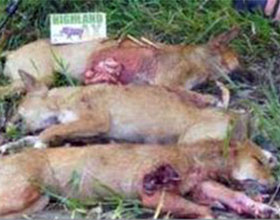
As though destroying dingo packs through baiting, traps, culling and bounties wasn't enough, some anti-dingo enthusiasts specifically search out dingo dens and cull dingo pups. In the wild, a dingo must reach two years of age before it is mature enough to breed. By seeking out dingo dens and killing the young pups within (0 - 4 weeks old), or by shooting youngsters that have begun exploring the outside world (5 - 12 weeks), anti-dingo enthusiasts are ensuring the permanent extermination of the dingo species.
Hunter Bounties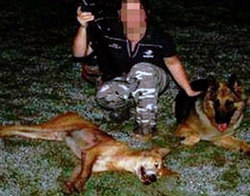
Most states across the country have established 'wild dog' hunting bounties that encourage the general public to hunt 'wild dogs' for cash. Wild dogs include dingoes, dingo-hybrids and domestic dogs turned feral. More often than not, these bounty hunters are delivering dingo carcasses for the collection of their reward. In Victoria four million dollars has been granted to the destruction of wild dogs. In January 2013 the state of Victoria doubled its Wild Dog Bounty from $50 to $100 per pelt to provide an additional incentive to hunters. Western Australia mirrored this action and has also established a $100 bounty per wild dog pelt. This kind of short term thinking will cause the extinction of many more Australian native species as feral predators like cats, and feral competitors like goats, will flourish in the absence of the dingo - the only native capable of managing feral pest numbers.
1080 Baits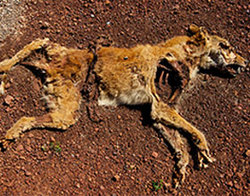
Banned in most developed countries, sodium monofluoroacetate (1080) poison is used liberally throughout Australia to control dingoes and other animals. When ingested (usually through baited food), the animal suffers a prolonged and horrific death spanning up to 44 hours for herbivores and 21 hours for carnivores. Effects of the poison begin with restlessness, diarrhoea and excessive salivation and then progresses to seizures, semi-paralysis, involuntary limb movements, extrusion of the tongue and penis, eye rolling, teeth grinding, rapid and laboured breathing, choking and then finally death.
1080 not only has devastating consequences for the animals that directly consume it, but it also affects the surrounding environment and its inhabitants. Scavengers and carnivores are killed through secondary poisoning when they feed upon carcasses that have died from the poison. 1080 spreads so thoroughly through an ecosystem that birds have been killed by eating insects that have fed on poisoned carcasses and poisoned food. Traps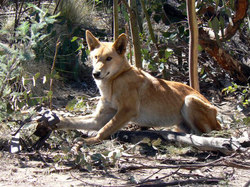
Dingo trapping is prevalent throughout Australia, with spring-loaded steel jaw traps set around water sources, dens and other areas that dingoes are known to frequent. These traps are set with a significant amount of pressure that often break the legs of the animal caught within the snare. If not broken, the leg is nearly always lacerated and joints dislocated. Often left to die of dehydration, starvation, or hypothermia, the dingoes caught within these traps suffer a painful and prolonged death which may take up to a week. If the dingo is found by the trapper before dehydration, starvation, or hypothermia takes it life, the dingo is likely to be shot or bludgeoned to death by the trapper.
Dingo Fence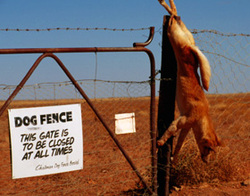
The Dingo Barrier Fence is the world's longest
fence, spanning over 5,400 kilometers. The dingo is considered a native animal north of the fence and considered a pest in sheep grazing areas south of the fence. Dingo control is particularly intensive along the South Australian section of the Dingo Barrier Fence. A 10–30 km buffer zone is regularly baited with sodium monofluoroacetate (1080) poison baits to kill any dingoes in the area. The dingo fence confines dingoes to arid areas where food and water is scarce. |
Save Our Dingoes National Action for Dingoes
The dingo is the only Australian mammal not protected under the National Parks and Wildlife Act. Dingoes are the only native Australian animal NOT protected by the National Parks and Wildlife Act. Please protect little Nala (featured above) from anti-dingo enthusiasts who are pushing governments for her species’ extermination. Sign the petition below to ensure all dingoes receive the national protection they deserve.
The dingo is the only native Australian animal not protected under the National Parks and Wildlife Act. As such, the fate of the Australian Dingo rests in the hands of the Australian public. Presenting our unified concerns to local, state and federal governments is essential in saving the dingo.
By signing the petition below you will be requesting the Australian Government to:
|

